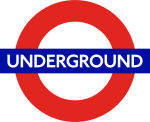
London Underground
Rapid transit system in England / From Wikipedia, the free encyclopedia
Dear Wikiwand AI, let's keep it short by simply answering these key questions:
Can you list the top facts and stats about London Underground?
Summarize this article for a 10 year old
The London Underground (also known simply as the Underground or by its nickname the Tube) is a rapid transit system serving Greater London and some parts of the adjacent home counties of Buckinghamshire, Essex and Hertfordshire in England.[5]
| London Underground | |
|---|---|
 | |
 The nickname "Tube" comes from the circular tube-like tunnels through which the small profile trains travel. (Deep level Northern line London Underground 1995 Stock train) | |
 | |
| Overview | |
| Locale | Greater London, Buckinghamshire, Essex, Hertfordshire |
| Transit type | Rapid transit |
| Number of lines | 11[1] |
| Number of stations | 272 served[1] (262 owned) |
| Daily ridership | 3.23 million (Average for 2023/24)[2] |
| Annual ridership | 1.181 billion (2023/2024)[2] |
| Website | tfl |
| Operation | |
| Began operation | 10 January 1863; 161 years ago (1863-01-10) |
| Operator(s) | London Underground Limited |
| Reporting marks | LT (National Rail)[3] |
| Technical | |
| System length | 402 km (250 mi)[1] |
| Track gauge |
|
| Electrification | Fourth rail, 630 or 750 V DC |
| Average speed | 33 km/h (21 mph)[4] |
The Underground has its origins in the Metropolitan Railway, opening on 10 January 1863 as the world's first underground passenger railway.[6] It is now part of the Circle, District, Hammersmith & City and Metropolitan lines. The first line to operate underground electric traction trains, the City & South London Railway in 1890, is now part of the Northern line.[7]
The network has expanded to 11 lines with 250 miles (400 km) of track.[8] However, the Underground does not cover most southern parts of Greater London; there are only 33 Underground stations south of the River Thames.[9] The system's 272 stations collectively accommodate up to 5 million passenger journeys a day.[10] In 2020/21 it was used for 296 million passenger journeys,[11] making it one of the world's busiest metro systems.
The system's first tunnels were built just below the ground, using the cut-and-cover method; later, smaller, roughly circular tunnels—which gave rise to its nickname, the Tube—were dug through at a deeper level.[12] Despite its name, only 45% of the system is under the ground: much of the network in the outer environs of London is on the surface.[8]
The early tube lines, originally owned by several private companies, were brought together under the Underground brand in the early 20th century, and eventually merged along with the sub-surface lines and bus services in 1933 to form London Transport under the control of the London Passenger Transport Board (LPTB). The current operator, London Underground Limited (LUL), is a wholly owned subsidiary of Transport for London (TfL), the statutory corporation responsible for the transport network in London.[12] As of 2015[update], 92% of operational expenditure is covered by passenger fares.[13] The Travelcard ticket was introduced in 1983 and Oyster card, a contactless ticketing system, in 2003.[14] Contactless bank card payments were introduced in 2014,[15] the first such use on a public transport system.[16]
The LPTB commissioned many new station buildings, posters and public artworks in a modernist style.[17][18][19] The schematic Tube map, designed by Harry Beck in 1931, was voted a national design icon in 2006 and now includes other transport systems besides the Underground, such as the Docklands Light Railway, London Overground, Thameslink, the Elizabeth line, and Tramlink. Other famous London Underground branding includes the roundel and the Johnston typeface, created by Edward Johnston in 1916.